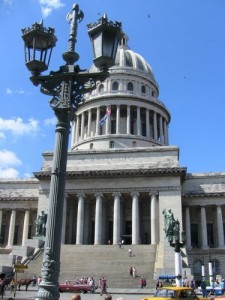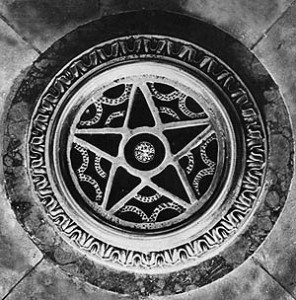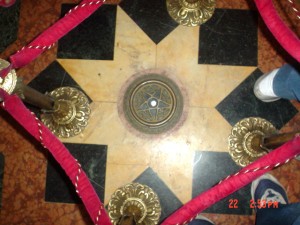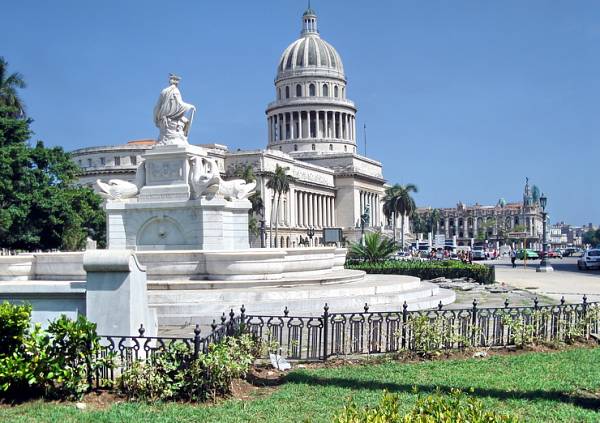The Capitol building in Havana is a significant building constructed in 1929 in Havana (Cuba) under the direction of architect Eugenio Raynieri Stone, to house and host of both houses of Congress or legislative body of the Republic of Cuba. Inspired by the classic Roman Capitol, the building has a neoclassical facade columnar and dome which reaches 91.73 m altura.
The Romans measured their distance from a landmark located in the Capitol. The French, from the famous Arc de Triomphe Paris, and in the U.S. on the East road system boots from the needle of the Capitol in Washington. Cuba couldn’t do less. In Havana, a beautiful jewel, a brilliant of 25 carat, recessed under the needle of the dome of the National Capitol still under construction, not only mark the starting point of Cuba’s Central highway, but that would bisect this luxurious space, a tunnel inspired cylindrical in the gallery of the Basilica of St. Peter in the Vatican. The left wing would correspond to the Senate, the right, to the House of Representatives.
The Minister of Public Works of Cuba Carlos Miguel de Cespedes in times of construction of the Capitol, was interested in acquiring that beautiful jewel to place in that magnificent work, the jeweler who owned the stone requested $ 12,000 for it. Workers, technicians, engineers and architects involved in the building of the work and to own contracting firm allegaron $ 9,000 pesos. The remaining $ 3,000 Carlos Miguel put in your pocket. When the Capitol was opened on May 20, 1929, the brilliant was already in place and its setting sumptuous carving and its striking yellow glow was the center of attention of national figures and foreign dignitaries attended that day to the inauguration of President Machado, determined extended in power against the opinion of the most responsible for the country. Two years later, on February 24, 1931, when the state, officially, the building passed to Congress, the jewel peak continued to attract visitors from Cuba and other countries.
He soon became one of the great attractions of the capital. In catalogs of American travel agents were attributed magical powers to the jewel, which, they said, healed the sick and radiated good luck.
On Monday 25 March 1946 mysteriously vanished 25 carat brilliant in the National Capitol marking the zero kilometer distances of all the Island At seven o’clock that day, after the change of guard, the guard Enrique Mena Police Senate, round by the Hall of Lost Steps, noticed his absence and reported to their superiors. The jewel was considered one of the best protected treasures of the Republic. She had been embedded in agate and platinum before inserting it into a block of andesite, granite strongest in the world, and this in turn was covered by another, concrete, embedded in the floor, in the center of the room. A cut-glass, which was estimated as solid unbreakable reinforced safekeeping.
He and the morning of 25 March 1946. The day had closed a large sample of Cuban painting in the Hall of Lost Steps, which attracted thousands of visitors during the days that remained open under the auspices of the Ministry of Education. Despite that there was in the Capitol and special surveillance of all was known that the night watch of the Palace of Laws eluded his rounds in the Hall for fear encountering the ghost of Senator Machado Clemente Vazquez Bello, killed by a revolutionary command in 1932, it was said, wandering around in the evenings. So it should not have been difficult for the thief or thieves, before they closed the building, hiding behind the paintings in the exhibition or in the back of the monumental statue of the Republic, and wait for the scheduled time.
Empty bedside bright estimators National Identification Office found the lining of a blood-stained hat, various phosphors used and a curious inscription in pencil on the floor. It read: “2:45 to 3:15 – 24 carat”. Indicating, apparently, the time that the robbers began their task and the time it took. No fingerprint. They said the theft was committed experts for experts. Miguel Suárez Fernández, President of the Senate, suspended without pay the firing that night police guarded the building and its members were under investigation.
An anonymous
Months passed, and the bright robbery seemed to have fallen into the category of perfect crimes when, on June 2, 1947, President Grau called his office to some of the most conspicuous figures in the regime. There were Senate President, Senator Carlos Prio, Senator Caíñas Milanes, Guillermo Alonso Pujol, senator and chairman of the Republican Party, the Ministers of Justice and Health, Cossío Alejo del Pino, brand new as Minister of the Interior (Interior) … Dr. Arturo Hevia attracted the attention of all present. It was the judge of the case brought by the jewel theft. Grau broke the silence.
‘Gentlemen, I have called this meeting for you to be witness of the delivery of the brilliant that I have received anonymously and who, it seems, is the same one that was stolen some time ago from the National Capitol. I am giving it to Dr. Hevia …
Shortly before noon on that June 2nd, Grau had had a long interview with Jose Manuel Aleman, the Minister of Education and amillonado protected Palace. They say it was he who put the jewel in the possession of the President, after paying 5000 dollars for his return. And confirmed Grau himself by declaring: “I do not care what they say about the appearance of bright. The truth is that it appeared. The rest is not important. German consulted before bringing me. I said yes and that was good publicity “.
But then to say, as has been done, that German was the mastermind of the robbery, goes a long way. It says, to complete the story, the minister wanted to give outdone jewel Paulina Alsina, cuñadísima the president and first lady of the nation. Where and in what circumstances she could wear the stolen gem? Not to mention that a man so close to the president could not commit such an act without putting in serious trouble and even ridiculed his illustrious friend and protector.
But only thirty minutes, apparently enough for thieves to steal the shiny fifteen months to reappear in official office of the president of the nation. Who stole it? Who it back? There are no answers to these questions. Like many other crimes that occurred in the period of Cuban governments (1944-1952) the theft was never investigated.
Sources: Wiki/CiroBianchiRoss/InternetPhotos/TheCubanHistory.com
Robo del Brillante del Capitolio/ The Cuban History/ Arnoldo Varona,Editor
ROBO DEL BRILLANTE DEL CAPITOLIO
El Capitolio Nacional de La Habana es un relevante edificio construido en 1929 en La Habana (Cuba) bajo la dirección del arquitecto Eugenio Raynieri Piedra, destinado a albergar y ser sede de las dos cámaras del Congreso o cuerpo legislativo de la República de Cuba. Inspirado en el clásico capitolio romano, el edificio presenta una fachada acolumnada neoclásica y una cúpula que alcanza los 91,73 m de altura.
Los romanos medían sus distancias a partir de un hito situado en el Capitolio. Los franceses, desde el célebre Arco de Triunfo parisino, y en EE UU el sistema vial del Este arranca desde la aguja del Capitolio de Washington. Cuba no podía ser menos. En La Habana, una bella joya, un brillante, empotrado bajo la aguja de la cúpula del aún por estrenar Capitolio Nacional, no solo marcaría el punto inicial de la carretera Central, sino que dividiría en dos ese lujoso espacio, una especie de túnel inspirado en la galería cilíndrica de la basílica de San Pedro, en el Vaticano. El ala izquierda correspondería al Senado; la derecha, a la Cámara de Representantes.
El Ministro de Obras Publicas de Cuba Carlos Miguel de Cespedes en momentos de la construccion del Capitolio Nacional, se interesó en adquirír aquella bella joya para colocarla en dicha majestuosa obra, el joyero a quien pertenecia la piedra pidió $12,000 por ésta. Obreros, técnicos, ingenieros y arquitectos que participaban en la edificación de la obra y hasta la propia firma contratista allegaron $9,000 pesos. Los $3,000 restantes los puso Carlos Miguel de su bolsillo. Cuando el Capitolio se inauguró el 20 de mayo de 1929, el brillante estaba ya en su sitio y por su engarce suntuoso, el tallado y su sorprendente fulgor amarillo fue el centro de la atención de las personalidades nacionales y los dignatarios extranjeros que ese día asistieron a la toma de posesión del presidente Machado, empeñado en prorrogarse en el poder en contra de la opinión de los sectores más responsables del país. Dos años después, el 24 de febrero de 1931, cuando el Estado, de manera oficial, traspasó el edificio al Congreso de la República, la joya continuó siendo el punto máximo de atracción de los visitantes cubanos y de otros países.
Pronto se convirtió en una de las grandes atracciones turísticas de la capital. En catálogos de agencias de viajes norteamericanas se atribuían poderes mágicos a la joya, que, decían, curaba a los enfermos e irradiaba buena suerte.
El lunes 25 de marzo de 1946 se esfumaba misteriosamente el brillante de 25 quilates que en el Capitolio Nacional marcaba el kilómetro cero de todas las distancias de la Isla. A las siete de la mañana de ese día, tras el cambio de guardia, el vigilante Enrique Mena, de la Policía del Senado, de ronda por el Salón de los Pasos Perdidos, advirtió su falta y dio cuenta a sus superiores. La joya se consideraba uno de los tesoros mejor protegidos de la República. La habían engarzado en ágata y platino antes de introducirla en un bloque de andesita, el granito más fuerte del mundo, y este a su vez fue recubierto por otro, de concreto, al empotrarse en el piso, en el centro del Salón. Un cristal tallado, tan sólido que se estimaba irrompible, reforzaba su resguardo.
Llegó así la mañana del 25 de marzo de 1946. La víspera se había clausurado una gran muestra de pintura cubana en el Salón de los Pasos Perdidos, que atrajo a miles de visitantes durante los días en que se mantuvo abierta bajo los auspicios del Ministerio de Educación. Pese a eso no hubo en el Capitolio una vigilancia especial y de todos era sabido que la guardia nocturna del Palacio de las Leyes eludía en sus rondas el Salón por temor a toparse con el fantasma del senador machadista Clemente Vázquez Bello, ultimado por un comando revolucionario en 1932, que, se decía, vagaba por allí en las noches. Por eso no debió haber sido difícil para el ladrón o los ladrones, antes de que cerraran el edificio, esconderse tras los cuadros de la exposición o en la parte trasera de la monumental Estatua de la República, y aguardar la hora oportuna.
Junto al lecho vacío del brillante, los peritos del Gabinete Nacional de Identificación encontraron el forro de un sombrero manchado de sangre, varios fósforos usados y una curiosa inscripción a lápiz en el piso. Decía: “2:45 a 3:15 – 24 kilates”. Lo que indicaba, al parecer, la hora en que los ladrones comenzaron su faena y el tiempo que les demoró. Ninguna huella digital. Aseguraron los peritos el robo fue cometido por expertos. Miguel Suárez Fernández, presidente del Senado, suspendió de empleo y sueldo al pelotón de la Policía que esa noche custodió el edificio y sus integrantes quedaron sujetos a investigación.
EN FORMA ANÓNIMA
Pasaron los meses; el robo del brillante parecía haber caído en la categoría de los crímenes perfectos cuando, el 2 de junio del 1947, el presidente Grau llamó a su despacho a algunas de las más conspicuas figuras del régimen. Allí estaban el presidente del Senado, el senador Carlos Prío, el senador Caíñas Milanés, Guillermo Alonso Pujol, senador y presidente del Partido Republicano, los ministros de Justicia y Salubridad, Alejo Cossío del Pino, recién estrenado como ministro de Gobernación (Interior)… El doctor Arturo Hevia atraía las miradas de todos los presentes. Era el juez instructor de la causa incoada por el robo de la joya. Grau rompió el silencio.
-Señores, les he citado para que presencien la entrega que voy a hacer de un brillante que he recibido en forma anónima y que, según parece, es el mismo que fue sustraído hace algún tiempo del Capitolio Nacional. Lo entrego al doctor Hevia…
Poco antes del mediodía de aquel 2 de junio, Grau había sostenido una larga entrevista con José Manuel Alemán, el amillonado ministro de Educación y protegido de Palacio. Se dice que fue él quien puso la joya en poder del presidente, luego de pagar 5 000 pesos por su devolución. Y lo confirmó el propio Grau al declarar: “No me importa lo que digan sobre la aparición del brillante. Lo cierto es que apareció. Lo demás es lo de menos. Alemán me consultó antes de traerlo. Yo le dije que sí y que eso era buena publicidad”.
Pero de ahí a afirmar, como se ha hecho, que fue Alemán el autor intelectual del robo, va un largo trecho. Se dice, para completar esta historia, que el aventajado ministro quería regalar la joya a Paulina Alsina, cuñadísima del presidente y primera dama de la nación. ¿Dónde y en qué circunstancias hubiera podido ella lucir la gema robada? Sin contar que un hombre tan cercano al mandatario no podía cometer un acto así sin poner en grave aprieto y hasta en ridículo a su ilustre amigo y protector.
Pero solo treinta minutos, al parecer, bastaron a los ladrones para sustraer el brillante, que quince meses reaparecería en el despacho oficial del presidente de la nación. ¿Quién lo robó? ¿Quién lo devolvió? No hay respuestas para esas preguntas. Como otros muchos hechos delictivos ocurridos en el periodo de los gobiernos auténticos (1944-1952) el robo del brillante del Capitolio quedó sin esclarecer.
Sources: Wiki/CiroBianchiRoss/InternetPhotos/TheCubanHistory.com
Robo del Brillante del Capitolio/ The Cuban History/ Arnoldo Varona,Editor



 The theft of the Capitol Jewel Robo del Brillante del Capitolio
The theft of the Capitol Jewel Robo del Brillante del Capitolio



